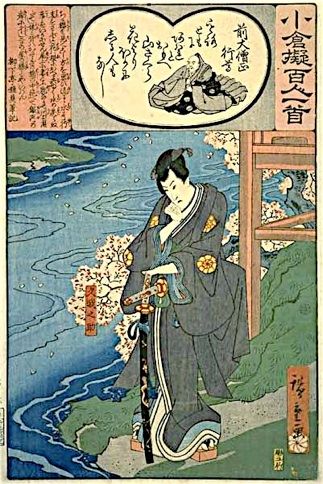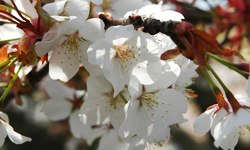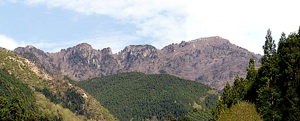前大僧正行尊


もろともに
哀れと思へ
山桜
花より外に
知る人もなし
さきのだいそうじょうぎょうそん
もろともに
あわれとおもえ
やまざくら
はなよりほかに
しるひともなし
Abbot Gyoson
Being together with you
Lonely and exalted
Mountain cherry tree,
Other than your blossom
No one else knows me.
Hiroshige
Daisojo Gyoson (1055 - 1135) or Saki no Daisojo Gyoson (saki means ‘retired’, daisojo is ‘archbishop’), was a son of Minamoto no Motohira, a grandson of prince Atsuakira, and a great-grandson of emperor Sanjo (poem 68). He was educated at Onjoji Temple (now called Miidera) and travelled a lot. He was a yamabushi, or mountain ascetic (who sometimes were armed). He served the emperor and later became the head of the Tendai sect (known for its violent internal clashes earlier). Forty-eight poems by him are known.
Gyoson and this poem are mentioned in the Chirizuka Monogatari (1569):
“At one time, Abbot Gyoson, the head priest of Enyuin Temple, came to a remote place in the mountain in the fourth month and gazed at the cherry blossoms in bloom. He recited this poem:


Mountain cherry blossoms,
Have a pity on me,
Only you know me
In this remote
Mountain village
Someone from the Nijo family [known for waka poetry] said that the true meaning of this poem could be understood only by people who had been in the mountain.
Lately, many people have gone into the mountain, but most of them reached only halfway up, and then returned talking about various things as if they had actually seen them all. This was especially true of the casual local mountain ascetics who were heard to brag before their masters about what they had seen in the mountain. But in reality, people said they had returned only from the foot of the mountain. They say there was a rule forbidding anyone to speak about the mountain. Before climbing it, both laymen and priests were obliged to vow not to repeat what they had seen there.”
This poem from the Chirizuka Monogatari is slightly different from the Hyakunin version in the fourth and fifth lines:
Hyakunin:
hana yori hoka ni (other than your blossom
shiru hito mo nashi. no one else knows me)
Chirizuka Monogatari:
hana yori hito mo (people rather than your blossom
shiruyoshi mo nashi do not know me well)
The commentators are divided over the meaning of the note heading this poem in the Kinyoshu: “composed when he saw cherry blossoms unexpectedly at Omine”. But omoi mo kakezu, ‘unexpectedly’, can simply be interpreted as ‘a pleasant surprise’ where he thought only pine trees grew he saw one solitary cherry tree. Omoikaku even means ‘to fall in love with’ or ‘to hope for’. The cherry blossom tree in poetry often stands symbol for a loved one.
Aware can mean ‘deeply moving, lonesome, sad, pitiful, beloved, dear, outstanding’.
It is a pity there is no known Hokusai woodcut for this poem.
The yamazakura, the mountain or wild cherry blossom, has five petals and a faintly pink white colour. It can be found predominantly on the slopes of Yoshino mountain.
Moro tomo ni
Aware to omoe
Yamazakura
Hana yori hito mo
Shiruyoshi mo nashi

Yamazakura
Mount Omine is a sacred mountain in Nara, south-east of Yoshino, famous for its controversial ban on women (the only remaining one in Japan - but only the Yamagaoke hill section of the mountain maintains the ban, which is not strictly observed) and for its three tests of courage. The Inamurageoka hill section of Mount Omine is reserved for women and is often called Nyonin Omine, ‘Women's Omine’. Officially known as Mount Sanjo it is more popularly known as Mount Omine due to its prominence in the Omine mountain range. It is located in Yoshino-Kumano National Park in the Kansai region.
The Ominesanji temple, located at the top of the mountain, is the headquarters of the Shugendo sect of Japanese Buddhism and the entire mountain is part of a pilgrimage and training ground for the modern yamabushi.

Mt Omine
